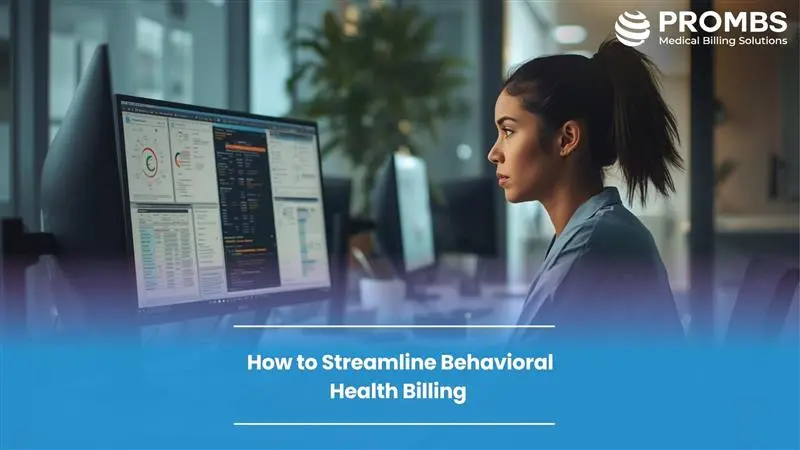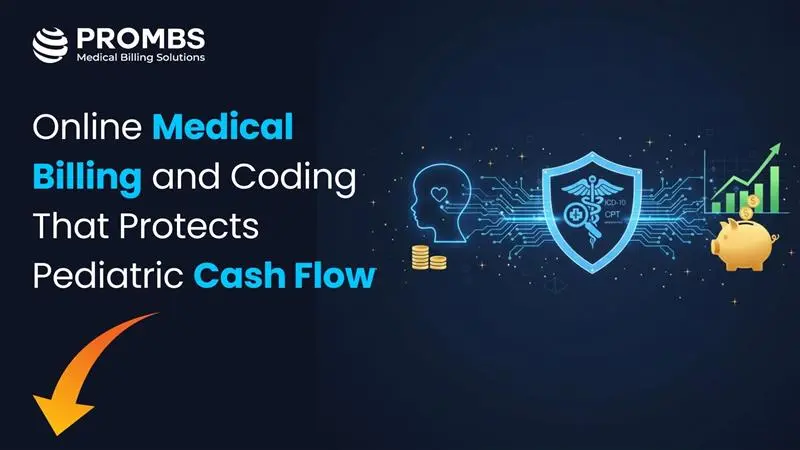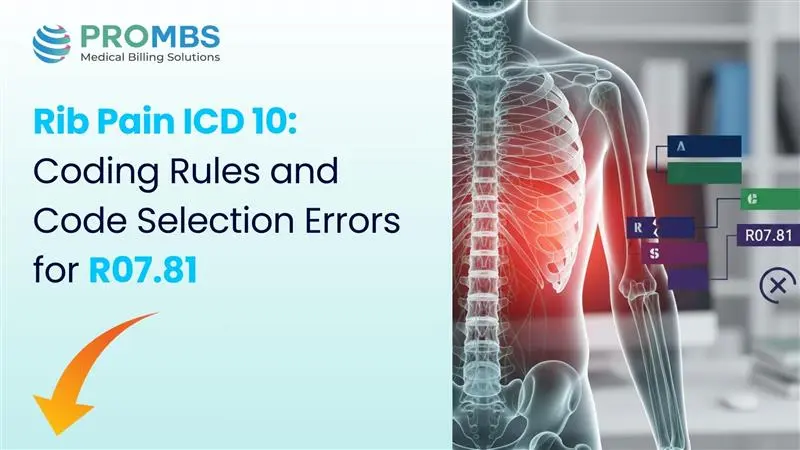Let’s be honest, behavioral health billing isn’t your typical medical billing process. It involves a complex mix of clinical documentation, payer requirements, and changing regulations that require accuracy at every step. From telehealth coding updates to payer audits and compliance checks, one small mistake can lead to delayed payments or compliance issues.
Whether you run a small outpatient practice or manage a large behavioral health group, how you handle your billing process can directly impact your cash flow and long-term growth. The right workflow, powered by the right behavioral health billing software, can turn complex processes into streamlined success.
In this article, we’ll show you practical ways to simplify and improve your behavioral health billing. We’ll connect the dots between real-world regulations from CMS, HHS, OIG, and AMA, and explain how an experienced partner like PROMBS can help you grow your operations with confidence and control.
Key Takeaway: Behavioral health billing success in 2025 depends on data-backed workflows, compliant documentation, and integrated billing technology. Practices that optimize their RCM see up to 30% fewer denials and faster payments.
Why is behavioral health billing more complex than traditional medical billing?
Behavioral health billing often demands stricter compliance with psychotherapy-specific documentation and modifier use compared to general medical claims, as outlined by the Centers for Medicare & Medicaid Services.
Why is Streamlining Behavioral Health Billing Essential in 2025?
As demand for behavioral and mental health care increases, so do payer audits and denials. According to the Substance Abuse and Mental Health Services Administration (SAMHSA)’s 2023 Behavioral Health Report, over 70 million Americans accessed mental health services, yet nearly 30% of claims faced administrative or coding rejections due to missing documentation or outdated payer rules.
This gap between patient volume and administrative capability underscores the need for efficient behavioral health revenue cycle management (RCM). In fact, the Office of Inspector General (OIG)’s 2023 Medicare Psychotherapy Audit showed that improper coding and insufficient documentation led to millions in overpayments, making compliance a top billing priority.
What Makes Behavioral Health Billing Different from General Medical Billing?
Behavioral health billing combines clinical nuance with payer-specific restrictions. While medical-surgical billing focuses on physical procedures, billing for behavioral health services relies on accurately timed psychotherapy sessions, clinical notes, and documentation of modality (in-person, telehealth, or hybrid).
The Centers for Medicare & Medicaid Services (CMS) emphasizes that only specific CPT/HCPCS codes, like 90832, 90834, and 90837, qualify for reimbursement under behavioral and mental health benefits. You can review the updated list in the CMS Medicare Mental Health Coverage Fact Sheet.
For organizations that deliver multiple service types, such as psychotherapy, medication management, or integrated care, the billing system must reconcile provider credentials, place of service (POS) codes, and supervision requirements.
How do new telehealth policies reshape behavioral health reimbursement?
As reported by the U.S. Department of Health and Human Services, permanent telehealth coverage now includes at-home and audio-only therapy, creating new billing challenges for clinicians.
How Does Telehealth Impact Behavioral Health Billing?
Telehealth has transformed the behavioral health landscape, not just in how care is delivered, but in how services are coded, documented, and reimbursed. What began as a temporary solution during the COVID-19 public health emergency has now become a cornerstone of mental health access and billing compliance.
According to the U.S. Department of Health and Human Services (HHS)’ Telehealth Policy Update, Medicare now allows behavioral health services to be provided to patients in their homes, including audio-only sessions when clinically appropriate. This change closed one of the biggest access gaps for rural and underserved patients who lacked video-capable devices. However, it also introduced new documentation and billing expectations that practices must meet to avoid denials or audits.
For example, the Centers for Medicare & Medicaid Services (CMS) now requires providers to document the technology used (audio or video), patient consent for telehealth delivery, and the exact time spent during the session. These details are critical when billing psychotherapy codes (90832–90837) or evaluation and management (E/M) services delivered virtually. Providers who omit these elements risk claim denials under the updated CMS telehealth billing guidelines.
From a compliance perspective, the Office of Inspector General (OIG) has also begun auditing behavioral telehealth claims to detect overpayments and ensure service authenticity, as detailed in its 2024 oversight work plan. Practices must ensure that the provider performing the telehealth session is credentialed, licensed in the patient’s state, and uses an approved HIPAA-compliant platform.
The Growing Role of Audio-Only Telehealth Sessions
In behavioral health, where therapeutic relationships depend on communication rather than physical examination, audio-only telehealth became a clinical necessity. CMS’s 2024 Telehealth Fact Sheet confirms ongoing coverage for telephone-based psychotherapy (CPT 99441–99443) for patients unable to participate in video sessions.
To bill correctly, clinicians must record why an audio-only format was necessary, for instance, lack of internet access or patient disability, and include duration and consent in the note. Billing platforms like PROMBS Behavioral Health Billing Software include built-in templates for telehealth consent and real-time tracking of session duration to ensure payer compliance.
Telehealth Modifiers and Place of Service Codes
When coding for telehealth in behavioral health billing, accuracy in modifiers and place of service (POS) codes is non-negotiable. The modifier 95 identifies synchronous telehealth services, while POS 10 represents “telehealth provided in the patient’s home,” and POS 02 covers “telehealth provided outside the home.” The American Medical Association (AMA) explains these distinctions in its modifier 95 guidelines.
PROMBS’s Modifiers Guide helps billing teams apply these codes consistently to prevent payer re-coding. If a claim uses POS 10 but omits modifier 95, many payers automatically flag it for review, resulting in delays or denials.
Telehealth Billing Compliance Checklist
| Compliance Step | Why It Matters | Authoritative Source |
|---|---|---|
| Document audio/video type and duration | Confirms service format and eligibility for telehealth reimbursement | HHS Telehealth Policy Update |
| Record patient consent for telehealth | Protects against post-payment audits by payers | CMS Telehealth Billing Guide |
| Use correct POS code (10 or 02) and modifier 95 | Prevents payer denial due to code mismatch | AMA CPT Telehealth Coding Resource |
| Ensure provider licensure in patient’s state | Maintains compliance with state telemedicine laws | OIG Work Plan |
How Telehealth Billing Connects to Behavioral Health Revenue Cycle Management
The financial implications of telehealth in behavioral health billing extend beyond compliance. Practices that integrate telehealth within their behavioral health revenue cycle management (RCM) workflows see higher patient retention and improved first-pass claim rates.
The Healthcare Financial Management Association (HFMA)’s 2024 RCM Insight Report found that integrating telehealth scheduling, documentation, and billing into a unified EHR-RCM system reduced behavioral health denials by up to 27%. PROMBS partners with providers to apply these insights, connecting appointment logs, therapy notes, and claims into a seamless workflow that keeps telehealth reimbursements consistent.
The Future of Telehealth in Behavioral Health Billing
As of 2025, the Bipartisan Policy Center’s Mental Health Funding Report projects that telehealth utilization for behavioral health will remain 30–40% higher than pre-pandemic levels. CMS has also proposed making telehealth flexibilities permanent for mental health under its CY 2025 Physician Fee Schedule Final Rule.
This means that future behavioral health billing processes must fully integrate telehealth as a default care model, not a temporary add-on. Clinics that invest in telehealth-friendly billing software and documentation standards now will be better equipped for the next wave of compliance audits and payer policy shifts.
What Are the Key ICD-10 Codes in Behavioral Health Billing?
The ICD-10-CM Chapter 5 (F01–F99) covers most mental, behavioral, and neurodevelopmental disorders. These include depression (F32.0–F33.9), anxiety disorders (F41.1), PTSD (F43.1), and bipolar disorder (F31.*). According to CMS’s Coding and Billing Guidance, these codes require clinical documentation that ties symptoms to functional impairment to demonstrate medical necessity.
PROMBS Tip: Use the ICD-10 code library within your EHR for clean problem lists. PROMBS helps teams map these codes directly to CPT services via smart edits — ensuring consistency and payer acceptance.
Insight: As the AMA’s Behavioral Health Coding Guide notes, clean psychotherapy coding reduces administrative rework and boosts claim acceptance by nearly 25% in high-volume behavioral health practices.
What Are the Most Common CPT Codes Used in Behavioral Health Billing?
Behavioral health coding depends heavily on time-based psychotherapy codes defined by the American Medical Association (AMA).
According to the AMA Behavioral Health Coding Resource, the key CPT codes include:
| Service Type | CPT Code | Session Time | Clinical Use |
|---|---|---|---|
| Psychotherapy (30 min) | 90832 | 16–37 minutes | Short sessions or progress checks |
| Psychotherapy (45 min) | 90834 | 38–52 minutes | Standard session for ongoing therapy |
| Psychotherapy (60 min) | 90837 | 53+ minutes | Extended session or complex case |
| Family Psychotherapy | 90847 | 50+ minutes | Therapy with family participation |
What Does Proper Documentation Look Like in Behavioral Health Billing?
Documentation is the backbone of clean behavioral health billing. The American Health Information Management Association (AHIMA) advises that compliant notes should record:
- Time spent (start and stop times),
- Clinical interventions used, and
- Patient’s progress toward treatment goals.
Following the AHIMA Coding Standards, every session must justify the code’s intensity and time threshold.
For instance, a note stating “60-minute CBT session with graded exposure” supports CPT 90837. A vague “therapy conducted for one hour” may not. PROMBS’s CMS-1500 Claim Form Guide helps ensure the narrative connects seamlessly to the billing line.
Why do most behavioral health billing denials happen—and how can you prevent them?
According to the Office of Inspector General’s audit summary, missing documentation and modifier errors remain the top causes of rejected behavioral health claims.
How Can Clinics Prevent Denials in Behavioral Health Billing?
A quick denial-prevention checklist based on AMA and CMS standards includes:
- Ensure psychotherapy notes contain both time and modality.
- Confirm that the diagnosis matches the treatment plan and CPT.
- Always append telehealth modifier 95 when applicable.
- Validate that the provider credentials align with the billed service.
Linking Documentation to Billing Accuracy
| Documentation Detail | Billing Impact | Trusted Source |
|---|---|---|
| Start and end times documented | Supports time-based CPT like 90832–90837 | AMA CPT Behavioral Health Coding Resource |
| Modality (audio/video/in-person) noted | Confirms telehealth compliance | HHS Telehealth Policy Updates |
| Diagnosis linked to treatment plan | Demonstrates medical necessity | CMS ICD-10 Coding Resource |
How Does Behavioral Health Billing Software Improve RCM?
Modern billing software for behavioral health integrates eligibility checks, automated claim scrubbing, and telehealth tracking in real-time. The CY 2025 Medicare Physician Fee Schedule Final Rule, published on CMS, emphasizes that accurate E/M time capture and digital claim edits are key to reducing administrative lag.
PROMBS integrates with such tools to create intelligent worklists that identify coding errors before claim submission, helping practices maintain over 97% clean-claim rates.
What Are CMS Behavioral Health Billing Guidelines for Integrated Care?
Collaborative care models (CoCM) and behavioral health integration (BHI) codes allow primary care providers to bill for psychiatric consultations and care coordination. CMS’s BHI FAQ outlines team composition, supervision levels, and time requirements for these codes.
A successful workflow uses structured templates that track care manager time and psychiatric review summaries. PROMBS’s Specialties Page provides examples of cross-specialty templates tailored for behavioral health programs.
What Are Common Denial Scenarios and How to Resolve Them?
When denials occur, behavioral health billing companies often find patterns like:
- CPT 90837 denied for exceeding time limits,
- Modifier 95 missing for telehealth claims,
- Place of service code mismatch (e.g., POS 10 vs. POS 11).
The HHS Office for Civil Rights and CMS OIG both stress accurate telehealth documentation and CPT alignment to prevent post-payment audits. PROMBS uses AI-driven denial analytics to spot recurring issues and link them back to documentation templates.
Compact Denial-Resolution Map
| Denial Type | Common Cause | Source |
|---|---|---|
| Telehealth Claim Rejection | Missing consent or modifier 95 | Reference HHS Telehealth Rules |
| Psychotherapy Code Denied | No time documentation | Cite AMA CPT Guidelines |
| Family Therapy Recoded | Incorrect CPT for session type | Check CMS MCD Article A57480 |
What KPIs Should Practices Track in Behavioral Health Billing?
According to the Healthcare Financial Management Association (HFMA), behavioral health RCM success is measured through metrics like clean claim rate (>97%), denial rate (<5%), and days in AR (<30). You can explore HFMA’s benchmarking resources at the HFMA Resource Library.
PROMBS helps providers implement automated dashboards that integrate these KPIs directly into their billing systems for real-time visibility.
Can outsourcing behavioral health billing really reduce administrative burden?
Studies by the Healthcare Financial Management Association show that practices outsourcing to certified behavioral health billing companies experience up to 30% faster reimbursements and 20% fewer claim rejections.
Why Partner With PROMBS for Behavioral Health Billing Services?
Behavioral health billing isn’t just about codes, it’s about sustaining patient care with financial precision. PROMBS provides end-to-end behavioral health billing solutions, combining compliance oversight, payer appeal expertise, and workforce extension under SLA-based performance guarantees.
Using PROMBS’s internal resources like Mastering Modifiers 59, 25, and 91 and the CMS-1500 Claim Guide, clients reduce claim errors and speed up reimbursements by 20–30%.
By aligning behavioral health coding, documentation, and claim submissions to authoritative sources from CMS, HHS, OIG, and AMA, PROMBS ensures every claim stands audit-ready — while your staff can focus on what matters most: patient care.



